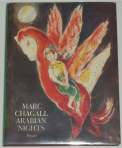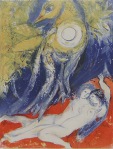Not the rarest of Nights books, nor the most important but the Chagall Nights is the most expensive of the Nights editions. Since The Arabian Nights was first published, in English, in 1706, there have been hundreds of different editions printed. Some will be very rare and it will be unlikely that I will ever see a copy, let alone own one. One copy of the Nights that I already know that I will never own is the Marc Chagall Arabian Nights.
In 1948 Marc Chagall produced a series of 13 lithographs based on four stories from The Arabian Nights. The stories were: The Ebony Horse, Julnar the Sea-Born and her Son King Badr Basim of Persia, Abdullah the Fisherman and Abdullah the Merman, and Kamar Al-Zaman and the Jeweller’s Wife.
The lithographs won the Graphic Prize at the Venice Biennial in 1948. To date, they are considered to be some of the very best examples of lithographic work done produced prior to 1950. They also represent Chagall’s first foray into colour lithography. Prior to this work, all of Chagall’s lithographs (35 in total) were in black-and-white. The predominant theme in the illustrations is that of separation or loss of love, reunion and the meaning of death. Chagall suffered the loss of his own wife prior to producing these prints. The stories he chose have themes of loss and reunion running through them.
Four Tales from the Arabian Nights. New York: Pantheon Books, Inc. 1948.
13 lithographs by Marc Chagall (1887-1985) (ref: Mourlot 36-48; Cramer 18) Printer was Albert Carman, City Island, New York.
Total edition of 111 copies. In two states:
A) The complete deluxe edition of 21. 10 numbered in roman numerals I-X and 11 lettered A to K (hors commerce). Each contained 13 signed, numbered and inscribed lithographs in colour, on laid paper, individual folders with text and reproductions of the artist’s line drawings, title page, and table of contents on wove paper, with full margins, loose. All in a ribbon-tied portfolio with printed title, brown linen-covered portfolio.
B) A numbered and signed edition of 90 published as a suite containing 12 of the 13 colour lithographs.
The original lithographs were 37 x 28 cm (14 9/16 x 11 in)
Copies of Chagal’s Nights have been broken up and the prints sold individually. They seem to go in the $10,000-$20,000 range. In Oct, 2008 a couple of individual plates (Plate 2: No 4/90, Plate 3: No 4/90) were sold at auction at Christies. They sold for $15,000 each. In May 2006 a complete copy of the deluxe edition(H of K) was sold at Christie’s for US$352,000. In April 2008, copy 58/90 went on the block and sold for US445,000. This set included an additional 16 unsigned, unnumbered progressive proofs. In April 2010, No. 62/90 sold at Christie’s for US$314,500. And, this past September 15, No. 70/90 sold at Christie’s for £217,250 (US$336,738).
When the Pantheon sets are broken up, the focus is on the lithiographs. I have never seen copies of the line drawings offered for sale.
Arabische Nächte. Verlag, München: R. Piper & Co, 1956, pp. 48.
13 colour illustrations, 13 black-and-white drawings with German captions.
This German publication was the first that I know of to reproduce the Chagall lithographs. It is a slim book and does away with the actual Nights stories. The book reproduces all of the 13 lithos and the associated black & white line drawings. It concludes with a brief essay on the lithograph. Book size is 19 x 12.5 cm.
Arabian Nights : Four Tales from a Thousand and One Nights. Munich: Prestel, 1988, Pp. 176.
/ Marc Chagall / ARABIAN NIGHTS / Four Tales / from a / Thousand and One Nights / With an introduction by / Norbert Nobis / Prestel /
Introduction by Norbert Nobis. 13 colour plates and 13 captioned black-and-white illustrations. Maroon cloth binding, hardcover with dust jacket, contained in a green cloth slipcase. Book size is 32 x 24 cm (12 5/8 x 9 5/8 in)
The plates in this edition were reproduced from the 1948 “J hors commerce” edition, owned by the Sprengel-Museum, in Hanover. They are printed using a 7 colour offset printing process on 180 g fine wood-free special art paper with a matte mould-made surface. Paper was produced by Maschinenund Buttenpapierfabrik.
The text of the four stories is based on the Sir Richard F. Burton translation.
Arabian Nights : Four Tales from a Thousand and One Nights, Munich: Prestel, 1999, Pp. 164.
/ Marc Chagall / Arabian Nights / Four Tales from A Thousand and One Nights / With an introduction by Norbert Nobis / [Publisher’s device: a Pegasus] / Prestel Munich London New York /
Introduction by Norbert Nobis, 13 colour full page plates and 12 detail inserts along with 13 captioned black-and-white illustrations. Dark blue paper boards with dust jacket. Book size is 24 x 16.5 cm (9 ½ x 6 ½ in).
The text of the four stories is based on the Sir Richard F. Burton translation.
Putting aside the original Pantheon edition, the 1988 Prestel edition is the most desirable one. The drawings are reproduced on quality paper and are the closest in size to the original lithographs. The 1999 edition is half the size and the 1956 German edition is even smaller. The German edition also lacks any of the stories.
The Chagall edition of The Arabian Nights is a good example of what I call an artist book. The Arabian Nights has been a source of artistic inspiration in the West for centuries. Illustrations have been included in Nights books since they were first published. In the artist books the stories are an adjunct to the illustrations. Typically, illustrations are used to enhance the text. In an artist book, the text is merely an excuse to show off the art. The Piper edition recognises this and strips the text away, leaving only the art. It is also evident in the original Pantheon issue. What is important are the lithographs. The text contextualizes them out and the text pages are abandoned when the set is broken up. The text is not important or necessary in the artist book.
The 13 colour lithos and their associated line drawings, from the 1956 edition have been posted on-line here. Just click the Next to step through the images. Here are a few of Chagall’s intrepertation of The Arabian Nights.
Disrobing her with his own hand, the King looked upon her body and saw it as it were a silvern ingot…
(From Julnar the Sea-Born)
So she came down from the tree and drawing near him strained him to her bosom…
(From Julnar the Sea-Born)
Then said the King in himself, “By Allah, I will not slay her, until I have heard the next of her tale.” So they slept the rest of that night in mutual embrace till day finally brake…







Your blog has by har the best information about Chagall and these lithos. I’d love to follow you but can’t seem to find a ‘Follow’ button on your site –
There may not be a Follow button as the site has been inactive for quite a while now.
I hope you’re still around… I believe I have a progressive proof of Mounting the Ebony Horse. It is signed in the plate in the same blue ink as in the print. I have never seen one like this, nor can I find any info on it. Your Blog is the only place I’ve found any mention of separate proofs. I’d really love to find out more about it if you can help. Thanks
Hi,
Unfortunately, I don’t have any more information on Chagall’s Arabian Nights lithographs. Pretty much everything I know about Chagall is in the post. My focus is mainly on the Arabian Nights and its publishing history in English. My interest in Chagall is his role as an illustrator of the Nights stories. I haven’t done any work on what other versions or copies of his lithographs there may be.